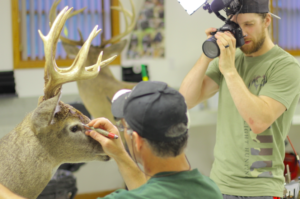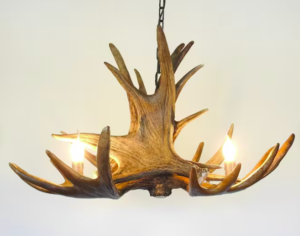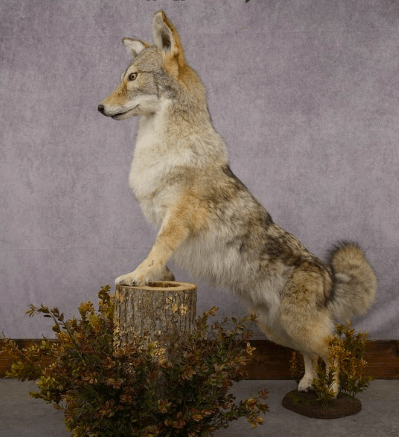
Coyote mounts Full Guide Taxidermy
Coyote mounts are enthralling and lifelike homage to one of nature’s most enigmatic and fascinating species. The coyote maintains a particular place in the hearts of wildlife enthusiasts and hunters alike as a symbol of adaptation and persistence. Coyote mounts provide a unique opportunity to experience the beauty of these creatures up close and to partake in the wonder of the natural world, whether as an aesthetic centrepiece in a rustic cabin, a trophy on display in a hunter’s lair, or an informative exhibit in a museum. We go into the art and science of coyote taxidermy in this exploration, revealing the processes, subtleties, and tales behind these perfectly constructed wildlife exhibits.
What exactly is a coyote mount?
A taxidermy display of a preserved coyote specimen is referred to as a coyote mount. A coyote mount is a lifelike reproduction of a coyote that has been prepared and mounted by a trained taxidermist. Taxidermy is the art and practise of preserving and mounting animals for exhibition or study.
Coyote mounts are made for a variety of reasons, including:
Hunting Trophies:
As a way to remember a successful kill, many hunters have their coyote trophies hung. These mounts frequently represent the coyote in a natural position, reflecting the harvest.
Educational Exhibits:
Coyote mounts are frequently used as instructional tools in museums, wildlife centres, and educational organisations. These mounts offer a close-up view of the animal’s anatomy, enabling for educational and scientific research.
Decorative Art:
Coyote mounts can also be made for ornamental and aesthetic purposes. They are frequently utilised in rustic or wildlife-themed home dcor, cabins, and lodges, where they offer a sense of nature to interior spaces.
Wildlife Photography:
Coyote mounts are used as props by certain wildlife photographers and filmmakers to create realistic scenarios for their work.
A coyote mount is a time-consuming and difficult operation. The taxidermist must first skin the coyote, conserving and preparing the hide.
How To Make A Coyote Mount Full Guide.
A coyote mount is a complicated and specialised taxidermy operation that necessitates expertise, experience, and specialised tools and materials. Because you may be working with animal specimens, taxidermy sometimes necessitates specific permissions and respect to local, state, and federal restrictions. A simplified outline of the main processes necessary in creating a coyote mount is shown below. This tutorial, however, is not a replacement for official taxidermy training and certification.
Materials and Tools:
Before you begin, you will need the following materials and tools:
- Coyote specimen (harvested legally and with proper permits).
- Taxidermy mannequin or form specifically designed for coyotes.
- Fleshing and skinning tools (fleshing knife, scalpel, scissors, etc.).
- Preservation materials (formaldehyde, borax, salt, etc.).
- Mounting hardware (screws, wire, etc.).
- Eyes, nose, and other artificial features (glass eyes, clay, etc.).
- Adhesives (epoxy, super glue, etc.).
- Paints and brushes (acrylic paints for touch-up).
- Protective gear (gloves, safety glasses, mask, apron, etc.).
- Mounting board or habitat base.
- Taxidermy tools (wire, needle, thread, etc.).
- Airbrush (optional).
Step-by-Step Guide:
Fleshing and Skinning:
- Begin by skinning the coyote carefully, taking care not to harm the hide.
- Remove all of the meat and fat from the hide, paying specific attention to the areas around the face and paws.
- To maintain the hide and prevent bacterial development, salt the flesh side. Allow it to settle for a few hours or overnight.
Mannequin Preparation:
- Choose a taxidermy mannequin or form that corresponds to the size and shape of your coyote.
- Change the mannequin’s stance to match the one you desire for your mount.
- Connect the mannequin to the mounting board or habitat foundation.
Preservation:
- Rinse the salt from the coyote hide and apply a preservation solution (for example, formaldehyde).
- Tack the skin on the model, making sure it is tight and well positioned.
Mounting:
- Secure the hide to the mannequin, making sure it is stretched and placed appropriately.
- Use mounting hardware and glue to securely attach the hide on the mannequin.
Facial Features:
- Following the anatomical outlines, insert glass eyeballs into the eye sockets.
- Using clay or other appropriate materials, sculpt a nose and lips.
Finishing Touches:
- Groom the fur so that it lies naturally.
- Paint the nose, mouth, and any other visible features to match the natural colours of the coyote.
- If needed, use an airbrush to add any final touches or embellishments.
Curing and drying:
- Allow the mount to cure completely in a cool, dry place.
- During the drying process, check for any touch-ups or changes that are required.
Habitat Base:
Make a habitat foundation or diorama for your mount that replicates the coyote’s natural habitat.
Seal and safeguard:
Seal the mount with a protective finish to keep it looking good for years.
Display:
Display your coyote mount proudly in your favourite area once it has cured completely.
Please keep in mind that taxidermy is a complicated and highly specialised subject, and before attempting to mount a coyote or any other animal, beginners should obtain official instruction from reputable institutes or expert taxidermists. Furthermore, all applicable rules and regulations governing the handling and mounting of animal specimens must be followed.
5 Best Coyote Mounts For Sale
1- Full Body Coyote Mount Taxidermy for sale

Amazing colours and hide condition on a full body coyote standing erect on a log end. This item has been meticulously crafted and is a must-have for collectors. A standing coyote would look great in a museum, lodge, or even with a private collector.
- SPECIES – COYOTE
- POSE -FULL BODY
- ACTION-UPRIGHT, STANDING ON LOG END
- DEPTH-23
- WIDTH-48
- HEIGHT-40
- WEIGHT-29
2- Coyote Taxidermy Shoulder Mount On Drift Wood For sale
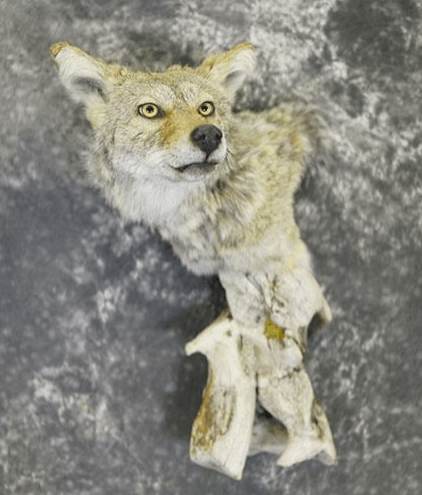
This coyote’s lifelike look was meticulously replicated, from the delicate intricacies of its fur to the intensity in its glass eyes. Every detail has been meticulously made.
Natural Pose: The coyote has been beautifully placed to reflect its original surroundings. This horse embodies the essence of the wild, with its head lifted high and alert.
Quality Craftsmanship: This shoulder mount demonstrates the taxidermist’s talent and passion to conserving wildlife’s beauty. It’s firmly mounted on a wooden plaque and ready for display.
- SPECIES- COYOTE
- POSE-SHOULDER MOUNT
- ACTION-LOOKING LEFT WALL PEDESTAL
3-Coyote Pedestal Taxidermy Shoulder Mount For Sale
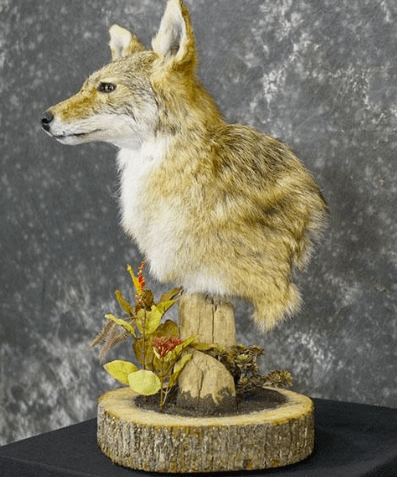
This coyote shoulder mount is in fantastic shape, conserving the animal’s natural beauty for future generations.
With this incredible coyote shoulder mount taxidermy, you can bring the wild spirit of the outdoors into your home. It’s more than just a decoration; it’s a work of art that celebrates the wonders of nature. Don’t pass up the chance to own it and display the magnificence of the coyote in your house or collection.
SPECIES- COYOTE
POSE-SHOULDER MOUNT
ACTION- PEDESTAL
4- Full Body Coyote Taxidermy Mount for sale

This finely made work of art depicts the coyote in all its glory, capturing every aspect of its shape and attitude. Our talented taxidermists have maintained the spirit of this renowned predator with lifelike accuracy, creating a sculpture that is both shockingly accurate and visually appealing.
This full body coyote mount is a beautiful and thought-provoking addition to any area, whether you’re a hunter honouring a noteworthy harvest or a nature lover trying to infuse your surroundings with the spirit of the outdoors. It is a monument to taxidermy craftsmanship as well as an opportunity to interact with the magnificence of the animal life.
- SPECIES- COYOTE
- POSE- FULL BODY
- ACTION- WALKING, SLIGHT LOOKING LEFT
- DEPTH- 11
How to care for a coyote mount?
Proper care is essential to the durability and look of your coyote mount. Here are some tips for keeping a coyote mount:
Regular Dusting and Cleaning:
Using a soft brush or feather duster, dust the mount on a regular basis. This keeps dust and dirt away from the fur and other surfaces.
Keep out of direct sunlight:
Keep your coyote mount out of direct sunshine and away from heat sources. Long-term exposure to sunlight can cause the fur and other materials to fade.
Avoid Moisture Damage:
To avoid mould and moisture damage, keep the mount in a dry environment. Taxidermy specimens might suffer from high humidity conditions.
Pest protection:
Make sure your mount is stored in a place where it won’t be damaged by insects or rats. Inspect it on a regular basis for signs of pests.
Avoid Touching:
Handling the mount should be kept to a minimum since oils and grime from your hands can transfer to the fur and progressively damage its look.
Cleaning and Restoration by Professionals:
If your mount gets badly filthy or damaged, consider having it cleaned and restored by a professional taxidermist. They have the knowledge to deal with more serious challenges.
Avoid Cleaning Products:
Cleaning agents and chemicals should not be used on the mount since they can harm the fur, hide, and other components.
Inspect the mount on a regular basis for symptoms of degeneration, loose hair, or damage. Early detection of problems can help to avoid additional damage.
Secure Mounting Hardware:
Make certain that the mount is securely fastened to its base or habitat. Loose mounts can become unstable and vulnerable.
Keep pets and children away:
To avoid inadvertent damage, keep your coyote mount out of reach of dogs and youngsters.
If you have a valuable coyote mount, consider insuring it against theft, damage, or loss.
Remember that adequate care and maintenance are required to keep your coyote mount in good shape. Following these rules on a regular basis will help guarantee that your taxidermy specimen stays a beautiful and valuable part of your collection or décor for years to come.
FAQs About Coyote mounts.
What exactly is a coyote mount?
A taxidermy exhibit of a preserved coyote specimen is known as a coyote mount. It entails preparing and putting a coyote’s skin on a mannequin or form in order to make a convincing depiction of the animal.
How are coyote mounts made?
Taxidermy is used to create coyote mounts, which entails skinning, fleshing, conserving the hide, mounting it on a mannequin, and adding artificial characteristics like as glass eyes and a sculpted snout. The procedure necessitates the use of specialised instruments and knowledge.
Where can I legally get a coyote to mount?
Depending on local and state rules, coyotes can usually be taken lawfully by hunting or trapping. It is critical to have the proper licences and to follow all hunting and wildlife rules.
Do I need any particular licences to have a coyote mount?
While possessing a coyote mount normally does not require any special licences, it is critical to confirm that the coyote was purchased properly and that you adhere with any local or state restrictions regulating wildlife possession.
How do I look after a coyote mount?
Regular dusting and cleaning, shielding the mount from direct sunlight and dampness, avoiding handling to avoid damage, and visiting a professional taxidermist for cleaning or restoration if necessary are all part of proper care.
Can I put a coyote mount outside?
Outdoor exhibition of a coyote mount is typically not suggested unless it is especially built for outdoor usage. The elements might deteriorate the mount over time.
Is there a difference between coyote mounts like as wall mounts and full-body mounts?
Yes, coyote mounts come in a variety of styles, including wall mounts (shoulder mounts) and full-body mounts. Personal preference and available display space influence the decision.
Is it possible to repair or restore a damaged or failing coyote mount?
Yes, taxidermists can frequently repair and restore damaged or decaying coyote mounts. For an examination and recommendations, consult a trained taxidermist.
Are coyote mounts appropriate for educational use?
Yes, coyote mounts can be used in schools, nature centres, and museums for instructional purposes. They allow for a close view and study of the animal’s anatomy.
Are there any legal limits on the purchase and possession of coyote mounts?
The laws and regulations governing the selling and possession of coyote mounts differ depending on where you live. It is critical to investigate and adhere to local and state wildlife rules.
Can I mount a coyote that I found deceased in the wild?
In many circumstances, mounting a slain coyote found in the wild is permissible, as long as you report the find to the right authorities and secure the necessary permissions or documents.
Related
Embark on a Journey of Mastery at Taxidermy Schools
Showcasing Majestic Beauty: Creative Elk Shoulder Mount Display Ideas.
The Grace of Red Hartebeest Mounts From The Best Taxidemist.
10 Best Deer Shoulder Mounts To Buy: The Art of Deer Mount Taxidermy.

